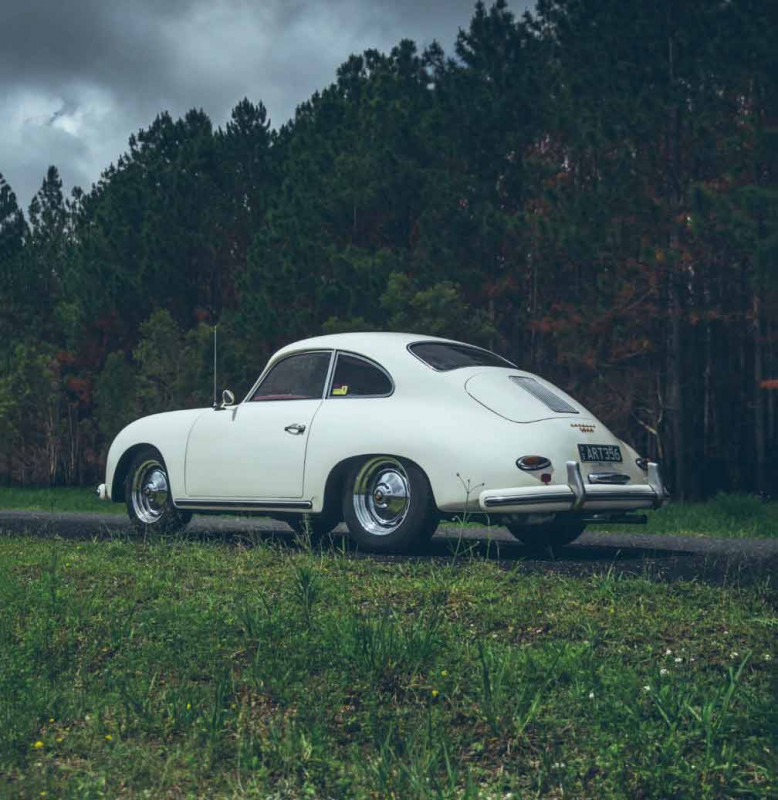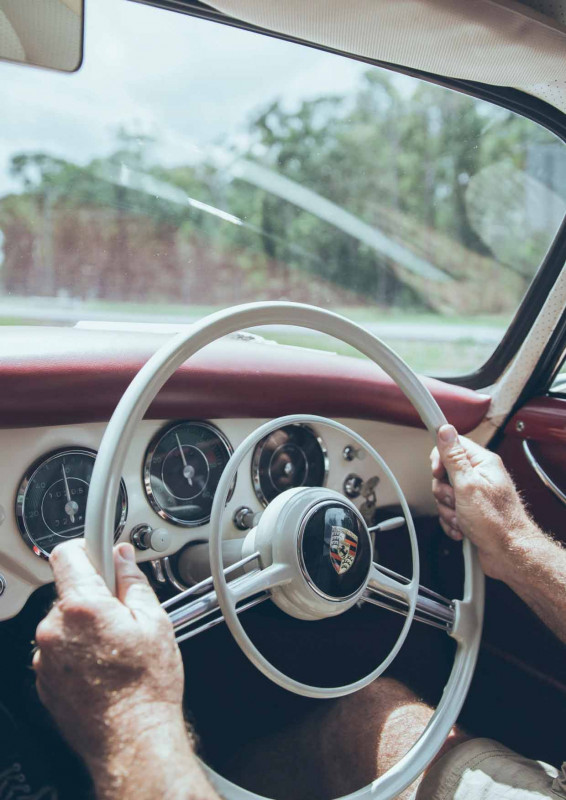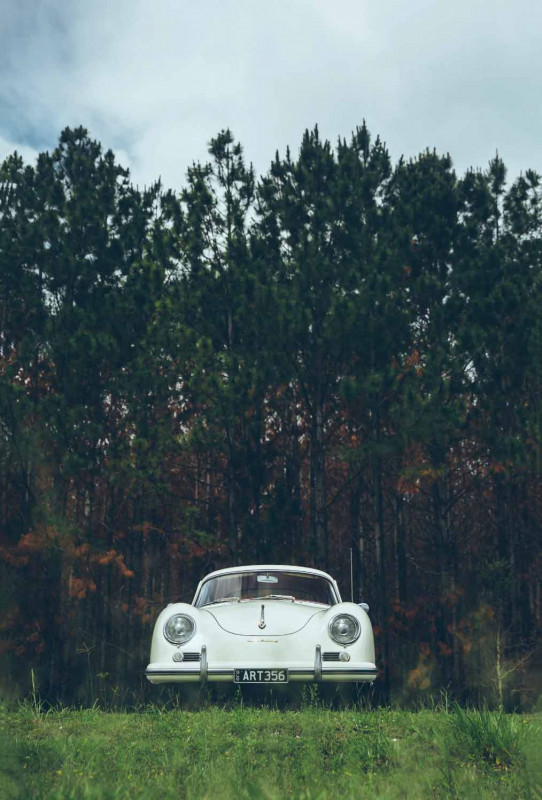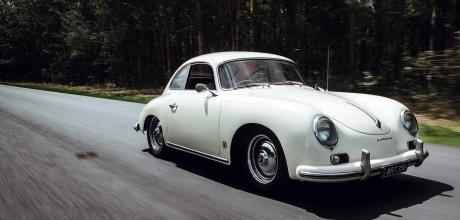1959 Porsche 356A
The workshop is crammed and dark, I carefully pick my way through the clutter, car parts, some recognisable others of indeterminate origin hang from the shed walls and are scattered in piles around this space.
It’s here that sculptor James Corbett painstakingly stitches together his work, breathing life into the inanimate and discarded.
I was expecting a stereotype, a dishevelled creative prone to meandering conversations on form. Instead I found a quietly spoken, disarmingly grounded and direct car nut. James and I chat about what inspires and drives his work, it’s soon very clear however, that there will be not arty waffle. You often get asked for these artist statements', he laughs good naturedly. 'They are usually so much bullshit'.
JAMES USES FOUND OBJECTS TO CREATE HIS WORK; CAR PARTS ARE THE PREFERRED MEDIUM
James uses found objects to create his work; car parts are the preferred medium. Discarded spark plugs, radiator grilles and engine parts are all reimagined to reflect living creatures or become motoring works of art. 'One of the things I like to think is that the end result is like a solved puzzle that in years to come will be like a time capsule from the age of the motor car'.

There’s always been something of the visual in James’s life. 'I was a signwriter back when we used to use brushes and paint'. He didn’t however do a traditional apprenticeship, instead while working in the screenprinting section of a signwriting business he taught himself. 'You have to remember back then around here art wasn’t even a subject at school', he pauses. 'In fact, if I’d been asked what I really wanted to do back then I would have said I wanted to be an automotive designer'. With a laugh he continues. 'At that time I may as well have said that I wanted to be an astronaut'.
THIS CAR ISN’T THAT FAST BUT IT’S A LOT OF FUN
The advent of computer-generated signage gave James pause to consider a change in career. He could see how the future was going to pan out for sign writing.
He bought a business specialising in dismantling French cars. 'It was just a business that was there', he says. 'I’d had a couple of Renaults before that time, I just liked that it was a cash business so I wouldn’t have to chase people to get paid. Though I was always something of a car nut'.

The journey from car wrecker to renowned sculptor may seem like a disjointed one, though to James there seemed a certain kind of logic to it. 'It was borne of frustration, I once saw in the back of a shot on TV a cat made from an exhaust manifold, it was pretty simple, just basic. But it was in my head and I remember thinking I could do better than that'.
'So one Saturday when it was raining I just sat down and thought I’d give it a go'. Those early pieces were displayed on the counter at the wrecking business. His inspiration appears quite diverse as well. 'Sometimes I see an object and think it would good to use in a sculpture, sometimes I see something, a dog or a car I want to make a sculpture of'.
'Sometimes you have to let things go instinctively and see where it will take you. Then you refine it and imagine it along the way, the best pieces though you have a pretty good idea in your head of what you want to end up with'.

'I like to create the illusion of life and movement out of this stuff, he says gesturing around the shed. 'I like to see children come up to something I’ve made, like a dog and pat it like its Alive. Whereas the car stuff I like to create the illusion of movement, the limit of adhesion. To animate it'.
Using car parts as a medium wasn’t so much borne from some sort of philosophical intent, so much as convenience at the time. 'They were there,' he shrugs with a faint smile. Though he does admit to thinking about the elements that make up his pieces.
JAMES IS CLEARLY BOTH AN ARTIST AND AN ENTHUSIAST WITH A DIFFERENCE
'Sometimes I look at a piece that may have say two or three hundred parts and think I’d like to know the history of each piece. The person in the factory that made them, who was the first owner, where did it go with that person'?
'How did it end up here? That would be a fantastic story'.
'The history of that mundane car is there, but at the same time it isn’t there'.
There’s an open wheeler ethos to his automotive tastes. 'They’re very mechanical. I like mechanical innovations'. However there’s no tribe to Jame’s tastes he has dabbled in off- road racing, hot rodding and what most would describe as classic sports cars.
SOMETIMES YOU HAVE TO LET THINGS GO INSTINCTIVELY AND SEE WHERE IT WILL TAKE YOU.
'If you asked me generally whether I have I have a set thing in cars I’d have to say I don’t. Though for me the ideal would be a Bugatti Type 35'.
'I like cars that look nice and handle well', he then adds wryly. 'And those don’t always go hand in hand. On the same token, I like cars that are pigs but that go fast'.
'I’ve owned about 20 or 25 cars over the years', he recalls. 'Not all of them very collectible'. To emphasise this he points to an ED XR6 Ford Falcon that the family has owned for years. There’s more than one shed in this conversation, there’s the crammed workshop and then there’s the light and bright space that houses one of James’s jewels, a 1959 Porsche 356A. A formula Ford racecar sits resplendent as if waiting for another race meet and in an adjoining shed a gorgeous 1974 Citroen DS23 Safari wagon sits waiting for the next dab of attentive restoration. We sidle through the clutter a flathead Mercury powered T-Model Ford sits in a back corner. It’s a home built replica of a 1930s dirt track racer.

Continuing the Porsche ownership theme is a Cayman R and a 1985 911 Carrera 3.2.
James is clearly both an artist and an Enthusiast with a difference. Although motor racing has been a constant part of his life. 'I’ve always been racing something of some description, be it motor bikes, off-road or historic cars since I was about 18 or 19', he says. 'Even when I was 12 I was always out at Lakeside watching a race even though none in my family was into it'.
James continues to race Formula Ford and in the past even raced a Renault R8 in the off-road sedan class.
JAMES USES FOUND OBJECTS TO CREATE HIS WORK; CAR PARTS ARE THE PREFERRED MEDIUM
However, James unsurprisingly has a clear interest in the iconic when it comes to vehicle design. The DS wagon for example is a reflection of an iconic design. 'It was as if they said that this is the best way we know how to build a car'.
With a chattering whir the 1600cc Porsche engine spins to life as James reaches for the driver’s door and closes it behind him. I follow it down the road as other homogenous vehicles flash by almost unnoticed. It’s not hard to be entranced by that simple iconic shape.
AN ICONIC CAR DOESN’T HAVE TO BE A FAST CAR, BUT IT HAS TO BE AN ENDEARING ONE.
In motion the antique white Porsche is something to behold. I reflect on our conversation back at the shed and the history of automotive design. 'An iconic car doesn’t have to be a fast car, but it has to be an endearing one'. 'The most fun cars around don’t have to be the fastest', James said, gesturing at the 356. 'This car isn’t that fast but it’s a lot of fun'.
Watching James at the wheel of the Porsche I sense that I can see a glimmer of that engagement in James’s automotive sculpture. The mechanical made bare. 'When I do a sculpture of a car I’m imagining that I’m the one driving that car'.
'It’s just an instinctive thing in me to do it'.
I LIKE TO CREATE THE ILLUSION OF MOVEMENT, THE LIMIT OF ADHESION. TO ANIMATE IT


